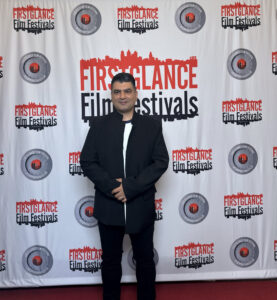BY: DAVID HAGLUND
Argo, the new movie from actor-director Ben Affleck, has mostly been getting raves—including a qualified but fairly strong endorsement from Slate’s own Dana Stevens, who calls it “a rollicking yarn” and “easily the most cohesive and technically accomplished of Affleck’s three films so far.” But several reviews have also noted just how far the movie departs in certain respects from the historical record. In the movie’s dramatic climax, Stevens writes, the “broadly accurate retelling of real events” gives way to “some fairly whopping dramatic license.” Similarly, New Yorker critic Anthony Lane—who also enjoyed the film—found it a “bit rich” that the movie pokes so much fun at “Hollywood deceitfulness” only to end “with an expert helping of white lies.” Former Slate film critic David Edelstein goes even further: NPR headlined his review “Argo: Too Good To Be True, Because It Isn’t.”
So just how accurate is Argo? And what are the white lies and dramatic whoppers the movie indulges in? We’ve tried to break it all down below. While it seems odd to offer a spoiler alert for a movie based on historical events, be warned that the rest of this post will discuss the movie in some detail. But you should also know that a lot of the most interesting details below aren’t in the movie at all—because, it turns out, much of the stuff Argo leaves out is even better than what made it in.
The Premise
Argo’s central, nutty storyline—in which the CIA establishes a fake movie production, complete with a full script and ads in Variety and The Hollywood Reporter, in order to rescue six Americans stranded in post-revolutionary Iran—is 100 percent true, and pretty incredible. The movie is largely based on a terrific article by Joshuah Bearman published five years ago in Wired, which you should read. (The script also draws on a memoir by Antonio Mendez, the man that Affleck plays in the film.) As Bearman explained in a chat with Gawker readers yesterday, the person who first told him about the story was an independent movie producer named David Klawans, who hoped that Bearman would report it out and write up a “nice yarn” that “might help kickstart a movie.” “Shockingly,” Bearman said, “it worked.” (Klawans is an executive producer of Argo.)
Canada’s Involvement
The most disputed aspect of the movie’s version of events has to do with Canada’s role in the escape. 30 years ago, Canada received complete credit for the rescue, because the U.S. was worried about possible repercussions if CIA involvement was publicized. (They may also have wanted to maintain the plausibility of a similar ruse in future.) Argo corrects that version of events—or, rather, overcorrects it, downplaying the actual extent of Canadian involvement, which was considerable. The Americans were housed by two Canadians: the Ambassador Ken Taylor, and a Canadian embassy employee, John Sheardown. (In the film, all of them stay with Taylor; Sheardown does not appear at all.) It was Taylor who cabled Washington to begin the escape plan in earnest, and once the plan was decided on, Canadians “scouted the airport, sent people in and out of Iran to establish random patterns and get copies of entry and exit visas, bought three sets of airline tickets,” and “even coached the six in sounding Canadian.”
Argo, the new movie from actor-director Ben Affleck, has mostly been getting raves—including a qualified but fairly strong endorsement from Slate’s own Dana Stevens, who calls it “a rollicking yarn” and “easily the most cohesive and technically accomplished of Affleck’s three films so far.” But several reviews have also noted just how far the movie departs in certain respects from the historical record. In the movie’s dramatic climax, Stevens writes, the “broadly accurate retelling of real events” gives way to “some fairly whopping dramatic license.” Similarly, New Yorker critic Anthony Lane—who also enjoyed the film—found it a “bit rich” that the movie pokes so much fun at “Hollywood deceitfulness” only to end “with an expert helping of white lies.” Former Slate film critic David Edelstein goes even further: NPR headlined his review “Argo: Too Good To Be True, Because It Isn’t.”
ADVERTISEMENT
The New York Times
SPONSORED BY THE NEW YORK TIMES
Support the journalists who seek the truth.
Benefit from expert reporting with this special offer from The Times.
Save now.
So just how accurate is Argo? And what are the white lies and dramatic whoppers the movie indulges in? We’ve tried to break it all down below. While it seems odd to offer a spoiler alert for a movie based on historical events, be warned that the rest of this post will discuss the movie in some detail. But you should also know that a lot of the most interesting details below aren’t in the movie at all—because, it turns out, much of the stuff Argo leaves out is even better than what made it in.
The Premise
Argo’s central, nutty storyline—in which the CIA establishes a fake movie production, complete with a full script and ads in Variety and The Hollywood Reporter, in order to rescue six Americans stranded in post-revolutionary Iran—is 100 percent true, and pretty incredible. The movie is largely based on a terrific article by Joshuah Bearman published five years ago in Wired, which you should read. (The script also draws on a memoir by Antonio Mendez, the man that Affleck plays in the film.) As Bearman explained in a chat with Gawker readers yesterday, the person who first told him about the story was an independent movie producer named David Klawans, who hoped that Bearman would report it out and write up a “nice yarn” that “might help kickstart a movie.” “Shockingly,” Bearman said, “it worked.” (Klawans is an executive producer of Argo.)
Canada’s Involvement
The most disputed aspect of the movie’s version of events has to do with Canada’s role in the escape. 30 years ago, Canada received complete credit for the rescue, because the U.S. was worried about possible repercussions if CIA involvement was publicized. (They may also have wanted to maintain the plausibility of a similar ruse in future.) Argo corrects that version of events—or, rather, overcorrects it, downplaying the actual extent of Canadian involvement, which was considerable. The Americans were housed by two Canadians: the Ambassador Ken Taylor, and a Canadian embassy employee, John Sheardown. (In the film, all of them stay with Taylor; Sheardown does not appear at all.) It was Taylor who cabled Washington to begin the escape plan in earnest, and once the plan was decided on, Canadians “scouted the airport, sent people in and out of Iran to establish random patterns and get copies of entry and exit visas, bought three sets of airline tickets,” and “even coached the six in sounding Canadian.”
ADVERTISEMENT
Almost none of that appears in Argo. Taylor himself has a major part, and is presented as a sympathetic and brave man who took great personal risks to save the Americans. But his actual role was even larger. He was “spying for the U.S. throughout the hostage crisis, at the request of Jimmy Carter.” After some friends who attended the Argo premiere in Toronto described it to Taylor, he expressed concern “that we’re portrayed as innkeepers who are waiting to be saved by the CIA,” which is a pretty fair description of what the film depicts. Affleck made a small change in response to this criticism: A postscript that contrasted Taylor’s 112 citations with the absence of credit given the CIA was rewritten to praise the Argo mission as a model of international cooperation.
The Escape
It’s not Canada’s involvement that has gotten the goat of some critics, though—it’s the pulse-pounding trip to the airport that serves as the movie’s climax. Affleck’s version involves every conceivable complication—each one of them, as it happens, invented purely to make the movie more exciting. (And it works! The finale is thrilling.) In the movie, the U.S. government reverses its approval of the plan at the last minute, meaning there may be no tickets waiting for the Americans when they arrive at the airport. In fact, the plane tickets were purchased ahead of time by the Canadians. Airport security guards stop the Americans in the film, leading to a tense and terrific scene in which one of the Americans makes the risky decision to speak Farsi with the guards, a daring move that pays off hugely. Actually, though, the trip through the airport was “smooth as silk,” as Mendez himself has written. Most improbably, the teams of carpet weavers that the Iranian government put to work repairing shredded documents (something they actually did!) piece together the face of one of the six Americans right as the group reaches the airport, and those carpet weavers relay the image to their higher-ups in time for armed men to chase down the departing airplane in a jeep and police cars. None of that happened.
SHARE
COMMENT
Argo, the new movie from actor-director Ben Affleck, has mostly been getting raves—including a qualified but fairly strong endorsement from Slate’s own Dana Stevens, who calls it “a rollicking yarn” and “easily the most cohesive and technically accomplished of Affleck’s three films so far.” But several reviews have also noted just how far the movie departs in certain respects from the historical record. In the movie’s dramatic climax, Stevens writes, the “broadly accurate retelling of real events” gives way to “some fairly whopping dramatic license.” Similarly, New Yorker critic Anthony Lane—who also enjoyed the film—found it a “bit rich” that the movie pokes so much fun at “Hollywood deceitfulness” only to end “with an expert helping of white lies.” Former Slate film critic David Edelstein goes even further: NPR headlined his review “Argo: Too Good To Be True, Because It Isn’t.”
ADVERTISEMENT
The New York Times
SPONSORED BY THE NEW YORK TIMES
Support the journalists who seek the truth.
Benefit from expert reporting with this special offer from The Times.
Save now.
So just how accurate is Argo? And what are the white lies and dramatic whoppers the movie indulges in? We’ve tried to break it all down below. While it seems odd to offer a spoiler alert for a movie based on historical events, be warned that the rest of this post will discuss the movie in some detail. But you should also know that a lot of the most interesting details below aren’t in the movie at all—because, it turns out, much of the stuff Argo leaves out is even better than what made it in.
The Premise
Argo’s central, nutty storyline—in which the CIA establishes a fake movie production, complete with a full script and ads in Variety and The Hollywood Reporter, in order to rescue six Americans stranded in post-revolutionary Iran—is 100 percent true, and pretty incredible. The movie is largely based on a terrific article by Joshuah Bearman published five years ago in Wired, which you should read. (The script also draws on a memoir by Antonio Mendez, the man that Affleck plays in the film.) As Bearman explained in a chat with Gawker readers yesterday, the person who first told him about the story was an independent movie producer named David Klawans, who hoped that Bearman would report it out and write up a “nice yarn” that “might help kickstart a movie.” “Shockingly,” Bearman said, “it worked.” (Klawans is an executive producer of Argo.)
Canada’s Involvement
The most disputed aspect of the movie’s version of events has to do with Canada’s role in the escape. 30 years ago, Canada received complete credit for the rescue, because the U.S. was worried about possible repercussions if CIA involvement was publicized. (They may also have wanted to maintain the plausibility of a similar ruse in future.) Argo corrects that version of events—or, rather, overcorrects it, downplaying the actual extent of Canadian involvement, which was considerable. The Americans were housed by two Canadians: the Ambassador Ken Taylor, and a Canadian embassy employee, John Sheardown. (In the film, all of them stay with Taylor; Sheardown does not appear at all.) It was Taylor who cabled Washington to begin the escape plan in earnest, and once the plan was decided on, Canadians “scouted the airport, sent people in and out of Iran to establish random patterns and get copies of entry and exit visas, bought three sets of airline tickets,” and “even coached the six in sounding Canadian.”
ADVERTISEMENT
Almost none of that appears in Argo. Taylor himself has a major part, and is presented as a sympathetic and brave man who took great personal risks to save the Americans. But his actual role was even larger. He was “spying for the U.S. throughout the hostage crisis, at the request of Jimmy Carter.” After some friends who attended the Argo premiere in Toronto described it to Taylor, he expressed concern “that we’re portrayed as innkeepers who are waiting to be saved by the CIA,” which is a pretty fair description of what the film depicts. Affleck made a small change in response to this criticism: A postscript that contrasted Taylor’s 112 citations with the absence of credit given the CIA was rewritten to praise the Argo mission as a model of international cooperation.
The Escape
It’s not Canada’s involvement that has gotten the goat of some critics, though—it’s the pulse-pounding trip to the airport that serves as the movie’s climax. Affleck’s version involves every conceivable complication—each one of them, as it happens, invented purely to make the movie more exciting. (And it works! The finale is thrilling.) In the movie, the U.S. government reverses its approval of the plan at the last minute, meaning there may be no tickets waiting for the Americans when they arrive at the airport. In fact, the plane tickets were purchased ahead of time by the Canadians. Airport security guards stop the Americans in the film, leading to a tense and terrific scene in which one of the Americans makes the risky decision to speak Farsi with the guards, a daring move that pays off hugely. Actually, though, the trip through the airport was “smooth as silk,” as Mendez himself has written. Most improbably, the teams of carpet weavers that the Iranian government put to work repairing shredded documents (something they actually did!) piece together the face of one of the six Americans right as the group reaches the airport, and those carpet weavers relay the image to their higher-ups in time for armed men to chase down the departing airplane in a jeep and police cars. None of that happened.
ADVERTISEMENT
The Fake Movie
Once Mendez got the go-ahead for the fake movie plan, he needed a real movie idea that his fake film company could pretend to have in production. In Argo, Mendez and the Oscar-winning makeup artist John Chambers—amusingly played by his actual doppelganger, John Goodman—go through dozens of scripts with a veteran Hollywood producer played by Alan Arkin (about whom more below), and Mendez spots a movie called Argo buried in the pile. In fact, Chambers thought of a script they could use soon after Mendez told him the idea. It was called Lord of Light, after the best-selling sci-fi novel by Roger Zelazny that it was based on. The Lord of Light script was part of a wildly ambitious scheme called Science Fiction Land, which would have been the first sci-fi theme park. In order to make that dream a reality, the script’s author, Barry Ira Geller, managed to enlist support not only from Chambers, but from Buckminster Fuller, Ray Bradbury, Paolo Soleri, and Jack Kirby—who made production drawings for the film. You can see one of them below. (In Argo, Mendez commissions storyboards himself, which are quite different from Kirby’s drawings.)
After Chambers showed Mendez the Lord of Light script, Mendez decided it needed a new name. He suggested “Argo” because it was part of his favorite knock-knock joke. “Who’s there?” “Argo.” “Argo who?” “Argo fuck yourself.” This last phrase is given a different origin story in Argo and becomes a very funny running gag. Geller, by the way, still hopes to get Lord of Light made some day, and producer-director Judd Ehrlich is trying to get a documentary about Science Fiction Land off the ground.
Alan Arkin’s Role
Among the major roles, the Hollywood producer played with great relish by Alan Arkin is the only one who is essentially fictional. Which is a bit ironic, since the character is himself presented as the embodiment of Hollywood bullshit. In Argo, Chambers tells Mendez they need a big-name producer to make the movie look legit, and he knows just the guy. In fact, Chambers brought in fellow make-up man Robert Sidell, who worked on E.T. among many other movies. The January 1980 Hollywood Reporter story that announced plans for Argo was headlined “Two make-up artists turn to producing with sci-fi ‘Argo.’ ” Arkin has said he based his character partly on Jack Warner.
SHARE
COMMENT
Argo, the new movie from actor-director Ben Affleck, has mostly been getting raves—including a qualified but fairly strong endorsement from Slate’s own Dana Stevens, who calls it “a rollicking yarn” and “easily the most cohesive and technically accomplished of Affleck’s three films so far.” But several reviews have also noted just how far the movie departs in certain respects from the historical record. In the movie’s dramatic climax, Stevens writes, the “broadly accurate retelling of real events” gives way to “some fairly whopping dramatic license.” Similarly, New Yorker critic Anthony Lane—who also enjoyed the film—found it a “bit rich” that the movie pokes so much fun at “Hollywood deceitfulness” only to end “with an expert helping of white lies.” Former Slate film critic David Edelstein goes even further: NPR headlined his review “Argo: Too Good To Be True, Because It Isn’t.”
ADVERTISEMENT
The New York Times
SPONSORED BY THE NEW YORK TIMES
Support the journalists who seek the truth.
Benefit from expert reporting with this special offer from The Times.
Save now.
So just how accurate is Argo? And what are the white lies and dramatic whoppers the movie indulges in? We’ve tried to break it all down below. While it seems odd to offer a spoiler alert for a movie based on historical events, be warned that the rest of this post will discuss the movie in some detail. But you should also know that a lot of the most interesting details below aren’t in the movie at all—because, it turns out, much of the stuff Argo leaves out is even better than what made it in.
The Premise
Argo’s central, nutty storyline—in which the CIA establishes a fake movie production, complete with a full script and ads in Variety and The Hollywood Reporter, in order to rescue six Americans stranded in post-revolutionary Iran—is 100 percent true, and pretty incredible. The movie is largely based on a terrific article by Joshuah Bearman published five years ago in Wired, which you should read. (The script also draws on a memoir by Antonio Mendez, the man that Affleck plays in the film.) As Bearman explained in a chat with Gawker readers yesterday, the person who first told him about the story was an independent movie producer named David Klawans, who hoped that Bearman would report it out and write up a “nice yarn” that “might help kickstart a movie.” “Shockingly,” Bearman said, “it worked.” (Klawans is an executive producer of Argo.)
Canada’s Involvement
The most disputed aspect of the movie’s version of events has to do with Canada’s role in the escape. 30 years ago, Canada received complete credit for the rescue, because the U.S. was worried about possible repercussions if CIA involvement was publicized. (They may also have wanted to maintain the plausibility of a similar ruse in future.) Argo corrects that version of events—or, rather, overcorrects it, downplaying the actual extent of Canadian involvement, which was considerable. The Americans were housed by two Canadians: the Ambassador Ken Taylor, and a Canadian embassy employee, John Sheardown. (In the film, all of them stay with Taylor; Sheardown does not appear at all.) It was Taylor who cabled Washington to begin the escape plan in earnest, and once the plan was decided on, Canadians “scouted the airport, sent people in and out of Iran to establish random patterns and get copies of entry and exit visas, bought three sets of airline tickets,” and “even coached the six in sounding Canadian.”
ADVERTISEMENT
Almost none of that appears in Argo. Taylor himself has a major part, and is presented as a sympathetic and brave man who took great personal risks to save the Americans. But his actual role was even larger. He was “spying for the U.S. throughout the hostage crisis, at the request of Jimmy Carter.” After some friends who attended the Argo premiere in Toronto described it to Taylor, he expressed concern “that we’re portrayed as innkeepers who are waiting to be saved by the CIA,” which is a pretty fair description of what the film depicts. Affleck made a small change in response to this criticism: A postscript that contrasted Taylor’s 112 citations with the absence of credit given the CIA was rewritten to praise the Argo mission as a model of international cooperation.
The Escape
It’s not Canada’s involvement that has gotten the goat of some critics, though—it’s the pulse-pounding trip to the airport that serves as the movie’s climax. Affleck’s version involves every conceivable complication—each one of them, as it happens, invented purely to make the movie more exciting. (And it works! The finale is thrilling.) In the movie, the U.S. government reverses its approval of the plan at the last minute, meaning there may be no tickets waiting for the Americans when they arrive at the airport. In fact, the plane tickets were purchased ahead of time by the Canadians. Airport security guards stop the Americans in the film, leading to a tense and terrific scene in which one of the Americans makes the risky decision to speak Farsi with the guards, a daring move that pays off hugely. Actually, though, the trip through the airport was “smooth as silk,” as Mendez himself has written. Most improbably, the teams of carpet weavers that the Iranian government put to work repairing shredded documents (something they actually did!) piece together the face of one of the six Americans right as the group reaches the airport, and those carpet weavers relay the image to their higher-ups in time for armed men to chase down the departing airplane in a jeep and police cars. None of that happened.
ADVERTISEMENT
The Fake Movie
Once Mendez got the go-ahead for the fake movie plan, he needed a real movie idea that his fake film company could pretend to have in production. In Argo, Mendez and the Oscar-winning makeup artist John Chambers—amusingly played by his actual doppelganger, John Goodman—go through dozens of scripts with a veteran Hollywood producer played by Alan Arkin (about whom more below), and Mendez spots a movie called Argo buried in the pile. In fact, Chambers thought of a script they could use soon after Mendez told him the idea. It was called Lord of Light, after the best-selling sci-fi novel by Roger Zelazny that it was based on. The Lord of Light script was part of a wildly ambitious scheme called Science Fiction Land, which would have been the first sci-fi theme park. In order to make that dream a reality, the script’s author, Barry Ira Geller, managed to enlist support not only from Chambers, but from Buckminster Fuller, Ray Bradbury, Paolo Soleri, and Jack Kirby—who made production drawings for the film. You can see one of them below. (In Argo, Mendez commissions storyboards himself, which are quite different from Kirby’s drawings.)
After Chambers showed Mendez the Lord of Light script, Mendez decided it needed a new name. He suggested “Argo” because it was part of his favorite knock-knock joke. “Who’s there?” “Argo.” “Argo who?” “Argo fuck yourself.” This last phrase is given a different origin story in Argo and becomes a very funny running gag. Geller, by the way, still hopes to get Lord of Light made some day, and producer-director Judd Ehrlich is trying to get a documentary about Science Fiction Land off the ground.
Alan Arkin’s Role
Among the major roles, the Hollywood producer played with great relish by Alan Arkin is the only one who is essentially fictional. Which is a bit ironic, since the character is himself presented as the embodiment of Hollywood bullshit. In Argo, Chambers tells Mendez they need a big-name producer to make the movie look legit, and he knows just the guy. In fact, Chambers brought in fellow make-up man Robert Sidell, who worked on E.T. among many other movies. The January 1980 Hollywood Reporter story that announced plans for Argo was headlined “Two make-up artists turn to producing with sci-fi ‘Argo.’ ” Arkin has said he based his character partly on Jack Warner.
ADVERTISEMENT
Ben Affleck’s Role
Tony Mendez is, on the other hand, very much a real person, of course. But Affleck gives him a little bit of Hollywood-friendly backstory that seems to be fictional. The first time we see Mendez in Argo he’s sleeping in a messy apartment all by himself; he and his wife are taking some time off, we soon learn, and it’s suggested that he’s lost some respect down at the Agency. Thus Affleck reinforces the feel-good quality of the story by providing a narrative of personal redemption as well: At the end, Mendez is a hero at work, and appears to reconcile with his wife and young son—who, in this version, helped inspire the sci-fi movie trappings of Mendez’s exfiltration plan. The real Mendez had two sons and a daughter with his first wife, who died of cancer in 1986. In his memoir, The Master of Disguise: My Secret Life in the CIA, he does not describe the kind of separation and reconciling that Affleck depicts. In fact, when he left for Tehran, his wife drove him to the airport.
You can watch Mendez talk about the actual mission in the clip below. It’s from an episode of the Errol Morris series First Person that was devoted to Mendez and titled “The Little Gray Man.”
















+ There are no comments
Add yours